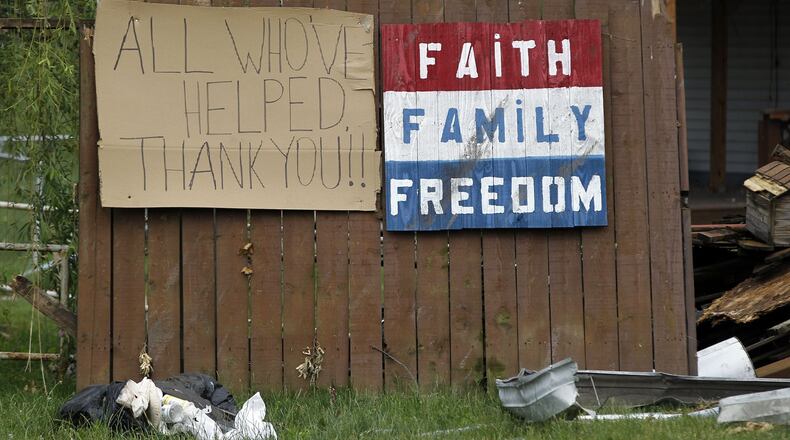The recovery process has been slow but steady, even despite a worldwide pandemic that hit less than a year later, temporarily halting efforts to rebuild as social distancing was prioritized and large gatherings avoided.
Now, according to the Miami Valley Regional Planning Commission, the region boasts a 97% property recovery rate since response efforts began just hours after the tornadoes caused damage ranging in severity from EF0 to EF4 within a 3 to 4 hour time frame.
Then vs. now
In Trotwood, Woodland Hills Apartments was left in ruins by the EF4 tornado that ripped through the city. That complex remains abandoned today, while nearby Westbrooke Village has been rebuilt and reoccupied.
In Harrison Twp., around 10 of the Rivers Edge Apartment buildings on Riverside Drive are still slab and grass, but the units on the other side of the street are lively.
To the northeast, there is hardly a trace left of Foxton Court, an apartment complex that was devastated by the tornado.
A sea of blue tarps that once covered many rooftops in the neighborhood behind the Marathon gas station on Wagner Ford Road in Dayton have since been replaced with shiny new siding, though there remains a handful of empty lots.
Immediate and long-term response
The morning after the tornadoes, The Dayton Foundation set up a fund specifically for response efforts, called the Dayton Disaster Relief Fund.
“As news spread across the region, an outpouring of support and donations began,” said Mike Parks, director of the Dayton Foundation, an organization that spearheaded recovery efforts alongside MVRPC and other local groups. “It continued for months as thousands of donations poured in, fueled by the tremendous kindness from people who wanted to help their neighbors.”
The fund ended up collecting just over $3 million, money that was used to assist in multiple phases of recovery, Parks said.
“The first was immediate recovery effort with the help of groups like the Salvation Army and Red Cross who were on the ground offering support for basic needs like food, shelter, and clothing. There were hundreds of people who were displaced with nowhere to go,” Parks said.
This phase, which was lead by the Miami Valley Long Term Recovery Operations Group, was categorized as “individual recovery” and lasted about 2 1/2 years, as area nonprofits joined forces, creating an intake case management system for those in need, assessing those needs, and responding to each accordingly using money from the disaster relief fund.
MVRPC created tornado dashboards on its website that have monitored the status of individual and property recovery efforts, compiling data from the case management system and from local jurisdictions.
The individual recovery monitor dashboard shows a total of 2,071 cases were opened as part of this phase one response, which was lead by the Miami Valley Long Term Recovery Operations Group.
Phase one wrapped up in October 2021 with a 96.86% recovery rate, the dashboard shows.
On the property side of things, of a total 5,699 properties affected by the tornadoes, 5,536 have been recovered as part of an effort lead by MVRPC, according to the latest data available on the property recovery dashboard.
According to MVRPC spokeswoman Laura Dent, the commission is still working with Harrison Twp. and Trotwood, the two communities hit hardest by the tornadoes, to provide comprehensive economic development planning efforts to aid in the final stages of their recovery.
As part of this work, a market study was conducted to examine areas of opportunities and challenges for both communities while identifying areas where the two jurisdictions can collaborate, according to Trotwood Community Investment Corporation Director Chad Downing.
A second phase, which is expected to be complete this fall, includes a more targeted approach to identify priority sites for redevelopment in both Trotwood and Harrison Twp.
“This phase is a site redevelopment plan, named the Turner Road Corridor Redevelopment Plan, since Turner Road and surrounding sites are areas of opportunity along the Harrison Twp. and Trotwood border,” Downing said. “Phase two is just getting started and will result in site-specific recommendations for priority sites in both communities, with the Hara Arena site and surrounding properties as a focus.”
Millions in local, federal funds
The Dayton Disaster Recovery Fund amassed $3 million in local funds and was used in three phases of recovery: immediate, individual, and community.
“Altogether, the immediate recovery — getting people water, clothes, helping them get a hotel room, meeting all of those initial needs — and the individual recovery — working to repair owner-occupied homes — used up about $2.15 million,” Parks said. “That left us with $850,000 for community recovery.”
This stage is expected to wrap up this year, according to Dent, and efforts have included funding toward the Tornado Survivor Pathways to Homeownership Program, grants to RETREET for replanting of trees — whether in places like Sinclair Park or at individual home sites — and funding assistance for individual recovery projects proposed by cities and jurisdictions.
On the federal level, a total of $43.1 million was leveraged as part of the region’s recovery process.
This includes $9.6 million from the Economic Development Association, which was allocated to the following projects:
- MVRPC disaster recovery coordination and Comprehensive Economic Development Strategy, $1.2 million
- City of Dayton water facilities, $3.6 million
- Greene County sewer upgrades, $3.7 million
- Miami Conservancy District North Dayton levee upgrades, $1.1 million
A total of $14 million was leveraged from the Federal Emergency Management Agency (FEMA) for public assistance and reimbursement for disaster response.
The U.S. Department of Housing and Urban Development leveraged $12.5 million to go toward Community Development Block Grant-Disaster Recovery affordable housing.
Lastly, $7 million was leveraged from the U.S. Department of Health and Human Services toward Substance Abuse and Mental Health Services Administration (SAMHSA) grants for mental health programs.
Looking ahead
Five years later, most of the remaining work is focused on future preparedness, Dent said.
MVRPC is working to create a “resiliency and preparedness plan,” which will serve as a guide to future recovery efforts should a disaster like this occur again.
“(MVRPC) has documented everything we’re gone through over the last five years, so the folks that come behind us don’t have to reinvent the wheel,” Parks said. “The goal with this is that if it happens again, the overall impact will be less on our communities.”
Despite the hurdles, Parks said he feels a prevailing message that should be highlighted when looking back on the events of Memorial Day 2019 and all that followed is one of perseverance.
“Dayton should feel really proud of how we all came together to care for those who were impacted,” Parks said. “Although it was a terrible experience, we showed our true colors by helping our neighbors.”
About the Author



